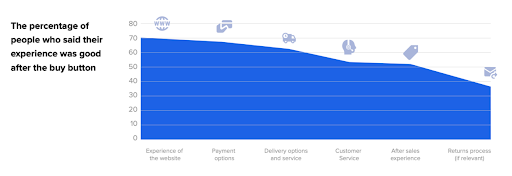Category Name - Ecommerce Trends
E-Commerce – 3 Simple Ways to Boost Your Customer Experience
E-Commerce is a complex, formidable undertaking for any company.- By sitemanager
- November 27, 2020
- 0

E-Commerce is a complex, formidable undertaking for any company. It’s comparatively easy to ace the basics like product descriptions, promotional videos, and checkouts, but these are little more than the tip of the e-commerce iceberg. There’s an ocean of things taking place behind the scenes from the moment a customer orders a product.
It’s a tough pill to swallow, but the last impression you leave is often what makes or breaks repeat business. If the last few steps of your process aren’t up to scratch, you risk turning customers elsewhere.

IMAGE ONE:The proportion of customers who felt they had a good experience after clicking “order”.
Some online research suggests that as many as ⅔ of reviews in the 1-3 star category describe failures in the customer experience rather than the product itself. Common complaints included:
- Poor communication
- Shipping fees that were perceived as unfair
- Slow delivery times
- Failure for items to arrive at all

IMAGE TWO:
10% of 280,583 reviews were between 1 and 3 stars.
77% of these 1-3 star reviews were related to the e-commerce process specifically.
It appears that maintaining a good reputation demands that the whole operational machine is well oiled; it’s not enough to just think about the front end.
So what can be done to make sure each aspect of your e-commerce process is well-tuned and ready to go? There are three simple things to keep in mind.

1 - Take a Long Hard Look at Your Business
This isn’t about tearing yourself down. It’s about assessing your business with a cold, rational eye and measuring your situation against tried-and-true retail KPIs. The research outline above suggests that the last few steps in the process are often where customers feel most let down.
For this reason, it’s best to focus primarily on order processing costs and order rate.
Order Processing Costs
It’s important to determine how much each order costs you to process. You can use the following calculation to figure out your processing cost per order:
Cost of Operations ÷ Number of Orders
To determine your cost of operations, consider your fixed costs and your variable costs.
Fixed costs are things like building hire and regular bills. Variable costs change depending on the number of orders you’re receiving. A high volume order will have different packaging costs than a small order, for example.
Only keep track of costs that are associated with delivering orders to customers.
Fixed Costs
Building Hire: $2,000
Employee Salaries: $7,100
Total: $9,100
Per Order: $4
Variable Costs
Packaging: $900
Total: $900
Per Order: $0.21
In the example above, the processing cost per order comes to $4.21.
Order Rate
In an ideal world, your order rate would be perfect. The order rate shows how common it is for orders to go wrong. Common failures include shipping the wrong item and delivering late.
If you can tweak your process so that no items are returned to you, everything is shipped promptly and each shipment is accurate and correct, then you’ll achieve the impossible – a 100% perfect order rate.
The best way to keep track of your rate is to note the number of failures and subtract from your total number of orders.
Case Study
Let’s say you shipped 900 orders in June. Throughout June you:
- Had to re-send 30 orders as a result of issues with the product
- Got complaints from 7 customers about slow delivery
In this example, your perfect order rate would be:
930 – (30+7) ÷ 930 = 96%. The 30 additional orders are also used for calculations as they could go wrong too.
Automate as Much as Possible
An automated system for your back office can inject some much-needed speed and efficiency into your e-commerce setup. This can drastically improve your customer service experience and buy you the freedom to invest in other aspects of your company.
An automated system can:
- Immediately redirect orders to the correct warehouse
- Update inventory levels seamlessly
- Automatically generate shipping labels with tracking references
- Create instant invoices
One example of a great automated back-office system is Brightpearl.
To make use of an automated system, consider the following:
- Determine the workflows already in operation at your company. This will make it easier to figure out the best way to manage things like inventory, returns, and orders.
- Figure out your requirements for each specific channel. You’ll need to know what you’re looking for in order to know which automation rules you’ll need.
- Establish your rules for automation. Set up the rules that will help your entire operation run more smoothly.

Aim to Deliver Perfect Customer Service
Retaining customers long term is a challenge, but the reward is worth it. Finding new customers is much more expensive than keeping existing ones.
It’s a tough world out there. The big names in e-commerce have created a landscape where 24-hour delivery is the norm. Almost 80% of customers on places like Amazon will leave a negative review if they’re unhappy.
Your goal should be growing brand loyalty. Our steps for automation above have the potential to transform your e-commerce operation. When done correctly, it can mean the difference between thriving and surviving.
Final Thoughts
If you’re pouring thousands into your front end, promotions, and order portals without considering the second half of the process, you’re doing something wrong. Every single step in the e-commerce process has to be well-maintained, perfectly optimized, and easy to tweak.
We hope this article has communicated how crucial it is to consider the last steps in the order and delivery process. The better your company gets at nailing the order rate, the higher your conversion and sales stats will go. If you approach automation with a robust, well-considered strategy, the results can be staggering.
Successfully implementing automation can transform the e-commerce experience for your customers.

